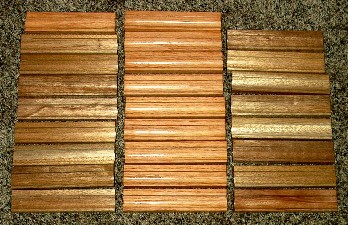
Pencil and name cups for a local teacher, Mrs. Mann. It's
hard to see, but there is an angled slit at the top for a name
card. At the bottom is a half-inch rounded groove for a
pencil. The wood is left-over oak, mahogany, and jatoba.
December 2003.
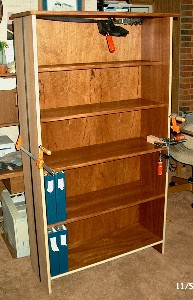
Test-fitting a bookshelf made of African mahogany. Not shown is
the face frame. All parts are mahogany plywood with solid
edges. The top two shelves are set back slightly to allow light
to shine down from an interior light (which I never ended up
adding). It is finished with several coats of amber shellac,
which looks amazing. November 2003.
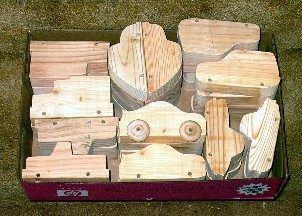
Toy cars I cut out for a Relief Society humanitarian aid
project. They painted the cars bright colors and installed wooden
axles and wheels. The shapes are mostly silhouettes of Hot
Wheels cars that I scanned and stretched on the computer to the needed
proportions. August 2003.
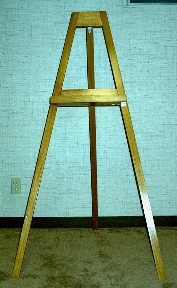
A music or poster easel for the Primary room. My children broke
an easel we were using during Cub Scout pack meeting, so I replaced it
with this one made of poplar. The middle leg is hinged at the top
and held in place by a brass chain. The other legs, cross braces,
and ledge are all biscuit joined together. It has a light coat of
honey maple gel stain and then a couple of coats of polyurethane.
April 2003.
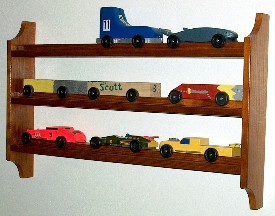
A shelf for the kids' pinewood derby
cars. It's made of some redwood that I had laying around and was
finished with spray polyurethane. April 2003.
A
pinewood derby track. It is made of four sections that are 8 feet
long and just under 1 foot wide. Each section is 1/4" plywood
with
1/8" melamine hardboard glued to it. The track guides are hickory
and were available at Lowe's in the exact size that was needed which
saved
a lot of time. The starting gate is spring loaded and uses a
screen
door latch. The finish gate uses flashlight bulbs,
photo-transistors,
and cheap digital watches to measure the racing time for each lane
individually.
The starting end of the track is held up by a fold-up tripod and was
lowered
to about 40" to keep the cars from running too fast. As it was,
the
fastest car measured 3.21 seconds on all three lanes. January
2002.
Pinewood derby car stands that I built
for the Cub Scouts. I made
14 of them from left over pine 2x2 and 3/4" birch plywood. The
scouts
screwed them together and painted logos on the front. The car is
Jonathan's and won
2nd
place in the Best Design category. The theme was the 2002 Winter
Olympics, so he made a bobsled. January 2002.
A doll bunk bed I made for Anne for Christmas. It is made of
scraps of hickory, fir, birch plywood, and alder. I used
the small face-frame biscuit size on my Porter-Cable joiner, which
worked well. The finish is wipe-on
polyurethane.
December 2001.
A picture frame I made of lacewood. It is very similar to the
frame
below except that it is a little larger and doesn't have the bevel cut
into the back. The finish is two coats of clear Danish oil
followed
by three coats of wipe-on polyurethane. This frame was made
specifically for the drawing by Randy Rouse of our four oldest children
with the Savior. December 2001.
My first hand carved frame. The rod and bead carving idea came
from
a Fine Woodworking magazine article and used two chisels that Janet
gave
me for my birthday. It is made of alder left over from David's
desk
and was eventually finished with two coats of clear danish oil and two
coats of wipe-on polyurethane. The corners have biscuits to
strengthen
them. It was a Christmas gift for my mother. November 2001.
These are some of the 88 stars I made out of yellowheart for a Relief
Society Christmas
dinner.
Here they are drying (they were dipped in wipe-on polyurethane).
Some of the stars are smaller (including some made out of maple).
These I made separately to give away as Christmas presents.
A play table for my cousin MeriKay's son. Since it's almost
as easy to build two, I built this one for our family. The legs
are
bolted on so the table can be broken down and slid under a bed.
The
top can be removed and flipped over so one side can be painted with
roads
or other decorations. The material is paint grade plywood, MDF
(side
rails) and pine. The top parts are all joined with biscuits and
gussets
for strength. The finish is water-based polyurethane and brick
red
acrylic paint. October 2001.
A garden tool rack made for Janet's mother. It disassembles so
she
could take it home in her suitcase. October, 2001.
A walnut box I made for Janet
to commemorate our 10th wedding anniversary.
The dovetails in the body have hand-cut pins and routed tails.
The
top has a small cove cut into and it floats in a dado in the lid.
The bottom works the same but doesn't have the cove. It is held
closed
with a half-mortise lock and is finished in several coats of clear
Danish
oil. I spent somewhere around 30-40 hours on it and it has the
first
dovetails I've ever made.
Gifts I made for my Sunday School class. Kelton Glorfield was
the only student to meet the challenge and he took the walnut box on
the
left. Spring 2001 (pencil cups) and Summer 2001 (boxes).
I made about 15 of these Post-It note
holders to give to co-workers after
finishing a project. Most were made of jatoba (a beautiful wood
also
known as Brazilian cherry) with red oak bases. I ran out of
jatoba
and so made a few out of all red oak (including this one), with the
base
stained to highlight the dovetail. These were the first things I
used my dovetail router bit to make. I think the sliding dovetail
joint added a very nice touch without adding a lot of work. May
2001.
The
first of two puzzles I made from padauk, yellowheart, and black
walnut.
There are four layers of puzzle pieces, each of which has about 20
pieces.
This one was finished with water-based polyurethane and the pieces were
dipped in wipe-on polyurethane. The other box was sold in an
auction
to raise funds for families of deceased military personnel. It
was
more oval shaped and was finished in Danish oil and a finishing
wax.
Spring 2001.
One
of the first things I made with my new band saw. The wood is
two chunks of alder glued together (it was left over from David's
desk).
The dark heart is a small piece of bubinga and it covers the screw that
holds the lid on. The bottom is felt lined and the clasp is made
of a piece of brass strip. January 2001.
A writing desk for David's 7th
birthday. The legs are solid alder
and the top and sides are birch plywood with the bad side out (I think
the bad side looks a lot like alder). The angled lid lifts up and
the drawer has a metal goldfish knob. The legs are doweled to the
sides (the only time I've used dowels and the only time I ever
will).
You can't see the leg braces, but they are joined to the legs with
mortises
and tenons about 4" above the floor. The finish is several coats
of water-based polyurethane. January 2001.
An organizer as a Christmas present for my brother Bryon and his wife
Kerrie. It is made of white maple and is finished with several
coats
of wipe-on polyurethane. December 2000.
A photo shelf I built out of crown
molding pieces. It is about 3
feet wide and 5 inches deep. The top has a groove cut in the back
that sits on two screws on the wall.
The new banister for our stairway. It is red oak with parts from
Home Depot. The rails are set into mortises in the posts and the
wall piece. These were the first mortises and tenons I ever made
and were all hand cut. The finish is wipe-on polyurethane, which
was the only reasonable way to finish all the intricate curves.
Fall
1999.
A video/DVD/CD cabinet. The case and shelves are 3/4" birch
plywood,
the
front is 1/2" birch plywood, and the back is 1/4" birch plywood.
All of it is edge banded with iron-on birch banding. The base is
way too small and needs to be redone to make it more stable (it is
currently
screwed to the wall to keep it from tipping). The hinges also
need
to be replaced with a full length piano hinge. The finish is
water-based
polyurethane.
A shelf for Anne. It attaches to the walls with keyhole slots in
the sides. The wood is red oak with water-based polyurethane
finish.
A music box for Janet that plays the Anniversary Waltz. The wood
is red oak and purpleheart and it's finished in water-based
polyurethane.
A bookshelf made of poplar. It was
perhaps the one and only foray
I will ever make into angular shapes. Though it's not the
prettiest thing,
it has held up well.
A marble hockey game that I made for the
kids for Christmas. The plans came from a woodworking
magazine. It is made of stained
poplar
and pine, except for the playing surface which is melamine coated
hardboard.